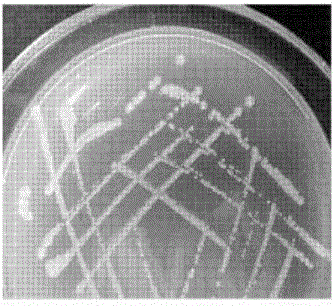Acquisition and application of a ginseng growth-promoting bacterium producing acc deaminase
A ginseng endophytic bacteria and ginseng technology, applied in the field of microorganisms, can solve the problems of slow growth, low germination rate of ginseng seeds, poor stress resistance, etc., and achieve the effect of promoting growth
- Summary
- Abstract
- Description
- Claims
- Application Information
AI Technical Summary
Problems solved by technology
Method used
Image
Examples
Embodiment 1
[0019] Example 1 Obtaining endophytic bacteria (Pseudomonas fluorescens) producing ACC deaminase activity of ginseng.
[0020] 120 strains of ginseng endophytic bacteria from Jilin Province were isolated by plate dilution method, and the strains with ACC deaminase activity were screened.
[0021] The screening is divided into primary screening and re-screening. The liquid culture method is used to screen 120 strains of bacteria in the primary screening. The strains to be tested are respectively inoculated into liquid LB medium and cultivated overnight at 28°C and 160r / min. Transfer 0.2 mL of culture medium to 8 mL of DF salt medium, and culture for 12 hours under the same culture conditions. Then take 0.2mL medium and transfer to 8mL ADF liquid medium again. And the ADF medium without ACC was used as the control. After culturing for 24-48 hours, measure the absorbance value at 600nm, repeat three times, and the positive strain is the one whose absorbance value is significant...
Embodiment 2
[0023] Example 2: Determination of other growth-promoting indicators of active bacterial strain JJ8-3
[0024] 1. Screening for the ability to decompose inorganic phosphorus: The PKO solid culture method was used for the primary screening. After culturing the JJ8-3 strain on NA medium for 12 hours, inoculate the bacteria plate on the PKO solid medium, and observe the phosphorus solubilization after culturing at a constant temperature of 28°C for 3 days. circle size. The second screening was carried out by molybdenum-antimony-scandium colorimetric method. JJ8-3 was inoculated into 50mL LB liquid medium by punching holes, and cultured at 160r / min for 12h. Take 1mL and inoculate it in a 150mL Erlenmeyer flask containing 50mL of PKO liquid medium. After 3 days, take 5mL of the culture solution, centrifuge at 8000r / min for 5min, and take the supernatant. Measure the soluble phosphorus content by molybdenum-antimony-scandium colorimetry. The results showed that on the PKO plate, th...
Embodiment 3
[0027] Embodiment 3: Identification of bacterial strain JJ8-3
[0028] Streak inoculation of JJ8-3 strain on NA medium, culture at 28°C for 12-24 hours, observe and record single colony morphology. JJ8-3 showed a light green opaque circular colony on NA medium, with complete and slightly transparent edges ( image 3 ), negative Gram staining, no motility, fluorescence observed under ultraviolet light ( Figure 4 ).
[0029]Take the JJ8-3 strain cultured in LB liquid medium for 24 hours, centrifuge and wash repeatedly with sterile water, suspend in an appropriate amount of sterile water for negative staining to prepare samples, and use tweezers to clamp the copper mesh with film to dip a small amount Bacteria solution, let it stand for 2min, blot the remaining liquid from the edge with filter paper; then use tweezers to clamp the copper mesh with bacteria and immerse it in a beaker filled with double distilled water for rinsing, then use filter paper to blot the liquid, and t...
PUM
 Login to View More
Login to View More Abstract
Description
Claims
Application Information
 Login to View More
Login to View More - R&D
- Intellectual Property
- Life Sciences
- Materials
- Tech Scout
- Unparalleled Data Quality
- Higher Quality Content
- 60% Fewer Hallucinations
Browse by: Latest US Patents, China's latest patents, Technical Efficacy Thesaurus, Application Domain, Technology Topic, Popular Technical Reports.
© 2025 PatSnap. All rights reserved.Legal|Privacy policy|Modern Slavery Act Transparency Statement|Sitemap|About US| Contact US: help@patsnap.com



